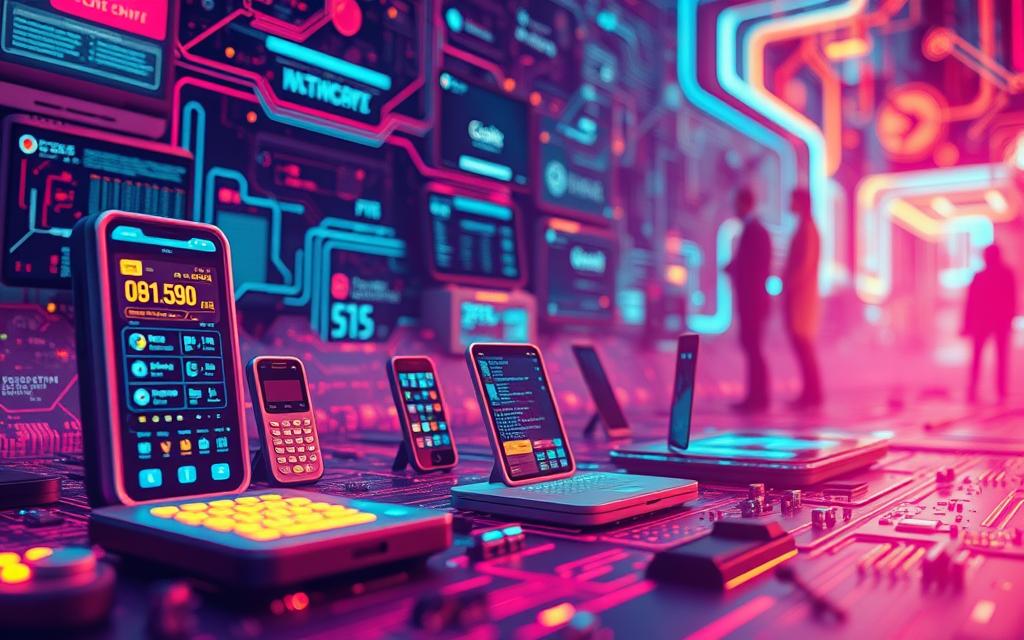Our way of talking to each other has changed a lot in recent years. It started with text messages and now we have advanced artificial intelligence. Our language is always changing fast.
Studies by the Max Planck Institute show how AI is changing how we speak. This change affects both our everyday chats and work talks.
Technology is making our language more uniform worldwide. It’s changing language in ways we never thought possible. This brings both problems and chances for how we talk today.
This piece looks into these exciting changes. It shows how digital tools are changing how we express ourselves. From simple text shortcuts to complex AI talks, it’s a big shift in language history.
The Dawn of Digital Communication
Digital platforms started in the late 20th century, changing how we talk and write. This time saw big texting language changes that became common. The move to digital from old ways opened up new ways to be creative and casual with words.
Early Internet Forums and Chat Rooms
In the late 1990s and early 2000s, AOL Instant Messenger changed how we chat. It made us type fast and use shortcuts. Words like LOL, BRB, and LMAO became part of our digital talk.
Internet forums and chat rooms were places where new words and ways of talking were born. They were different from old English, setting new rules for online talk. The need for quick typing and short messages made abbreviations popular.
These early digital places were where texting language changes started. They showed how tech can change language fast.
Email’s Influence on Written Correspondence
Email changed how we write, making it faster and easier. It mixed the speed of instant messaging with the formality of letters. This created a new way to write that was both casual and formal.
Email made us write shorter and get to the point quicker than letters. It made us use a more relaxed tone, even in work emails. This broke down old rules of formal writing.
From Formal Letters to Digital Messages
The move from writing letters to sending emails was a big change. Letters had strict rules and formal language, but emails were more flexible.
This change showed how society was moving towards being more casual and efficient in communication. Digital messages allowed for quicker and more spontaneous writing, changing how we write today.
These early digital platforms set the stage for today’s texting language changes. They made language more flexible, shaping how we talk and write now.
The Texting Revolution and Linguistic Innovation
The rise of mobile phones changed how we talk to each other. This texting revolution is a big deal in how language has grown.
Mobile phones made language change fast. What started as simple tricks became complex ways to communicate.
SMS Language and Character Limitations
Text messages had to be short, leading to new short forms. This led to “txt spk,” a quick way to write English.
Terms like LOL, BRB, and OMG came from this need for brevity. They’re now part of our digital talk.
These shortcuts weren’t just about saving space. They made talking online clear and quick.

Emoticons to Emoji: Visual Language Development
Emojis went from simple faces to a full visual language. They started with basic marks like 🙂 and grew into a big system.
Emojis added feelings to text messages. They helped avoid misunderstandings by adding emotional context.
This change in how we communicate is a big win for technology. Studies show emojis are more than just fun symbols.
Cultural Adaptation of Emoji Communication
Different places use emojis in their own ways. This shows how technology fits into local cultures.
Emojis can mean different things in different places. What’s okay in one place might not be in another.
This shows the link between technology and culture. Emoji use is a key area in social media linguistics, showing how digital tools take on cultural meanings.
| Communication Element | Pre-Texting Era | Post-Texting Revolution | Impact on Language |
|---|---|---|---|
| Abbreviations | Limited to specialised contexts | Widespread everyday usage | Increased linguistic efficiency |
| Emotional Expression | Mostly verbal descriptions | Visual symbols (emojis) | Enhanced emotional clarity |
| Character Constraints | No significant limitations | 160-character SMS limit | Forced conciseness |
| Global Understanding | Culture-specific expressions | Universal visual language | Cross-cultural communication |
The texting revolution changed how we write. It showed that limits can spark creativity.
This time of fast linguistic innovation shapes how we talk today. The early SMS patterns live on in today’s messaging.
Social Media’s Linguistic Transformation
Social media has changed how we talk to each other. It has created special ways of speaking that match each platform’s features. This change is a big deal in how language has evolved.
Hashtags as Organisational Language Tools
Hashtags started on Twitter and have become key tools for organising content. They help group posts and shape online discussions. Hashtags do many things in our digital talks:
- Categorising content across platforms
- Creating community around specific topics
- Amplifying social movements and trends
- Enhancing content discoverability
Now, people use “hashtag” in speech to highlight points or add fun. This shows how tech has changed our way of talking.
“Hashtags have evolved from simple metadata markers to cultural signifiers that shape how we organise and discuss ideas in the digital age.”
Platform-Specific Communication Styles
Every social media site has its own way of speaking. This is because of its technical limits and what users expect. These styles show how tech affects our language and how we act online.
Twitter’s Concise Expression Paradigm
Twitter’s short character limit made users talk in a clear, impactful way. This led to new ways of writing, like using short words and creative punctuation.
Twitter’s fast pace makes language quick and trend-focused. New words and phrases from Twitter often become common in everyday talk.
Instagram’s Visual Narrative Language
Instagram focuses on pictures with text. Captions add to the story told by images. This mix of image and text is unique.
Instagram users often express feelings and tell personal stories in captions. This style of writing goes well with the pictures. It’s a new way of communicating through both words and images.
| Platform Feature | Linguistic Characteristic | Communication Impact |
|---|---|---|
| Character Limits | Brevity and efficiency | Forced conciseness drives creative expression |
| Visual Dominance | Complementary captioning | Text supports, doesn’t lead, communication |
| Algorithmic Sorting | Keyword optimisation | Influences word choice for discoverability |
| Community Standards | Self-censorship patterns | Shapes polite and inclusive language use |
Each platform’s language shows how tech changes how we talk. Social media’s algorithms act like search engines, favouring certain words and phrases.
Knowing these digital dialects is key for good communication in today’s world. As platforms change, so does how we speak online.
Search Engines and Query-Based Language
The digital world has changed how we find information. Search engines are now our main way to learn. This change has made our language unique, shaped by how algorithms work.

Keyword Optimisation and Search Behaviour
SEO has changed how we write and search. In the past, people stuffed content with keywords to trick search engines. This made text sound unnatural and focused too much on algorithms.
Now, SEO is about understanding what users really want. Search engines look for content that answers questions, not just matches keywords. This has led to more natural, conversational searches.
Our search habits have changed a lot:
- We now ask full questions instead of just keywords
- Voice searches have grown by 35% in two years
- We use local terms more in our searches
- We expect quick, direct answers to our questions
Algorithmic Influence on Language Patterns
Search algorithms shape our language as much as we shape them. Google’s updates have led to a change in how we write and speak online. This is called algorithmic linguistic adaptation.
This effect is not just for professionals. Everyday users have also picked up on these changes. We often use language that search engines prefer without even realising it.
Voice technology has made our searches even more natural. We talk to devices like we would to people, using full sentences and questions.
| Search Era | Primary Language Style | Characteristic Features | User Behaviour Changes |
|---|---|---|---|
| Early Web (1990s-2000s) | Keyword-focused | Short, fragmented queries | Boolean operators, exact matching |
| Social Media Era (2000s-2010s) | Hashtag-driven | Categorisation through tags | Trend participation, community language |
| AI Integration (2010s-present) | Natural language | Question-based, conversational | Voice search, expectation of direct answers |
The future of search technology and AI will bring even bigger changes. As algorithms get better at understanding us, our searches will become even more natural. This will make our communication with machines feel more like talking to people.
Voice Technology and Spoken Interaction
Voice technology has changed how we talk to machines. It’s not just about giving commands anymore. Now, we have real conversations that feel like talking to people.
Voice Assistants: Amazon Alexa, Google Assistant
Today’s voice assistants have changed our daily routines. They understand what we mean and can handle many tasks at once. They even know who’s speaking in a room.
Amazon Alexa and Google Assistant are now part of our homes. They can answer complex questions that were hard to imagine a few years ago.
Natural Language Processing in Daily Use
Natural language processing lets these systems get what we say. They understand the context, our tone, and even our accents.
This technology lets us talk naturally. We don’t have to remember special phrases. It makes talking to machines feel more like talking to people.
“Voice technology has transformed from simple command recognition to understanding the nuances of human conversation.”
Speech Recognition Accuracy Improvements
Speech recognition has made huge leaps forward. Now, systems can understand us over 95% of the time, even when it’s noisy.
Improvements include:
- Better background noise filtering
- Accent and dialect recognition
- Real-time processing capabilities
- Contextual error correction
These changes mean voice tech can handle different ways of speaking. It even adapts to how each person talks.
| Year | Recognition Accuracy | Key Development |
|---|---|---|
| 2015 | 78% | Basic command recognition |
| 2018 | 88% | Contextual understanding |
| 2021 | 94% | Multi-language support |
| 2023 | 97% | Emotional tone detection |
The AI language influence goes beyond just understanding us. It also creates responses that sound natural and right for the situation.
This progress shows how voice tech is changing how we talk. The line between talking to humans and machines is getting thinner.
Artificial Intelligence and Language Generation
Artificial intelligence has changed language in a big way, like the printing press did before. AI is not just for talking; it helps shape how we speak and understand words.

Large Language Models: ChatGPT and Google Bard
ChatGPT and Google Bard have changed how we talk to tech. They learn from lots of text to answer questions and talk about many things.
They can do more than just answer questions. They write poems, business emails, and even code in a way that sounds like us.
AI-Generated Content and Linguistic Patterns
Studies at the Max Planck Institute show interesting things about AI’s language. AI often uses certain words and phrases more than humans do.
Words like “delve,” “adept,” “meticulous,” and “realm” show up a lot in AI writing. This makes AI writing easy to spot.
The Imperva report says AI content is a big part of what we see online. This makes us think about the realness and originality of digital messages.
Machine Translation Services Evolution
Machine translation has come a long way. It’s no longer just swapping words. Now, it understands the context and even cultural references.
Today’s translation AI doesn’t just translate words. It gets the meaning, considers the culture, and keeps the style when it can.
Real-Time Cross-Language Communication
Now, we can talk in real time, even if we speak different languages. AI helps us understand each other better.
This technology is changing how we do business, learn, and connect with others. It breaks down language barriers that used to hold us back.
But, there’s a downside. Linguistic homogenisation is a worry. AI might make all languages sound the same, losing the unique touches that make language special.
Some fear that using AI too much could make languages more uniform. This could make language less diverse and interesting.
How Has Technology Changed Our Language
Technology has changed how we talk and connect. It has brought new words and changed how we share thoughts and feelings. This section looks at how technology has changed our language.
Accelerated Linguistic Evolution Pace
Technology has made language change faster. What took centuries before now happens in decades. For example, Shakespeare’s impact on English took generations, but now new words spread worldwide in weeks.
Artificial intelligence helps speed up language change. It creates and shares language patterns on a huge scale. This feedback loop between humans and machines drives new language ideas.
This fast change brings both benefits and challenges. Schools find it hard to keep up with new language trends while teaching the basics.

Globalisation of Language Trends
Digital platforms have made language travel the world fast. Internet memes and viral phrases spread everywhere quickly. This shows how language trends can go global in no time.
Now, we have a global vocabulary thanks to the internet. Emojis are a great example. They help people from different cultures and ages understand each other better.
But, local languages are also changing. Communities mix global trends with their own words, creating unique language styles.
Formal and Informal Language Convergence
The line between formal and informal language has blurred online. Professional emails now use casual language and emojis. This shows how digital communication is changing.
Emails are a good example of this shift. Business emails use contractions and emoticons, which were once seen as too casual.
This change reflects a shift in how we work and communicate. Technology has made communication more open and friendly, moving away from strict rules.
AI-generated content adds to this mix. It combines technical language with a friendly tone, setting new standards for professional writing.
Conclusion
Technology has changed how we talk to each other, from old digital forums to new AI systems. This change is getting faster, with each new thing opening up new ways for us to express ourselves.
Looking ahead, we need to think about keeping our languages diverse. Big language models like ChatGPT and Google Bard might make us all talk the same way. It’s important to keep our languages different.
AI needs to be developed with care. Companies making AI should follow rules that respect different cultures. And we, the users, need to be mindful of how these tools change how we talk.
The future of language tech is about finding a balance. AI is amazing, but our creativity and cultural differences are unique. We must help this tech make our language world richer, not poorer.







